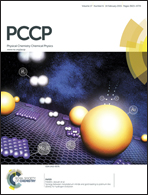Experimental and theoretical charge density distribution in Pigment Yellow 101†
Abstract
The charge density distribution in 2,2′-dihydroxy-1,1′-naphthalazine (Pigment Yellow 101; P.Y.101) has been determined using high-resolution X-ray diffraction and multipole refinement, along with density functional theory calculations. Topological analysis of the resulting densities highlights the localisation of single/double bonds in the central C![[double bond, length as m-dash]](https://www.rsc.org/images/entities/char_e001.gif) N–N
N–N![[double bond, length as m-dash]](https://www.rsc.org/images/entities/char_e001.gif) C moiety of the molecule in its ground state. The density in the N–N is examined in detail, where we show that very small differences between experiment and theory are amplified by use of the Laplacian of the density. Quantification of hydrogen bonds highlights the importance of the intramolecular N–H⋯O interaction, known to be vital for retention of fluorescence in the solid state, relative to the many but weak intermolecular contacts located. However, a popular method for deriving H-bond strengths from density data appears to struggle with the intramolecular N–H⋯O interaction. We also show that theoretical estimation of anisotropic displacements for hydrogen atoms brings little benefit overall, and degrades agreement with experiment for one intra-molecular contact.
C moiety of the molecule in its ground state. The density in the N–N is examined in detail, where we show that very small differences between experiment and theory are amplified by use of the Laplacian of the density. Quantification of hydrogen bonds highlights the importance of the intramolecular N–H⋯O interaction, known to be vital for retention of fluorescence in the solid state, relative to the many but weak intermolecular contacts located. However, a popular method for deriving H-bond strengths from density data appears to struggle with the intramolecular N–H⋯O interaction. We also show that theoretical estimation of anisotropic displacements for hydrogen atoms brings little benefit overall, and degrades agreement with experiment for one intra-molecular contact.


 Please wait while we load your content...
Please wait while we load your content...